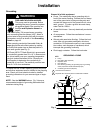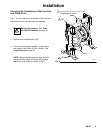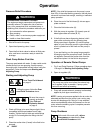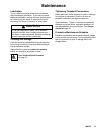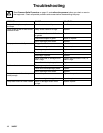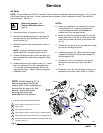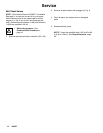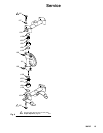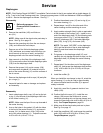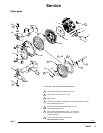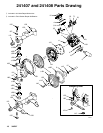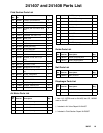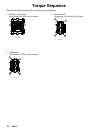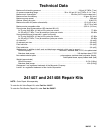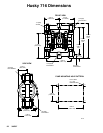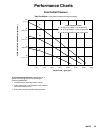
16 308797
Service
Diaphragms
NOTE: Fluid Section Repair Kit D05977 is available. Parts included in the kit are marked with a double dagger (})
in Fig. 7 and in the Parts Drawings and Lists. General purpose grease 111920 and Adhesive 113500 are supplied
in the kit. Service the diaphragms as follows. See Fig. 7.
Disassembly
1. Relieve the pressure. See
Pressure Relief Procedure on
page 10.
2. Remove the manifolds (102) and fluid cov-
ers (101).
NOTE: Make sure all the check valve parts stay in
place. See Fig. 6 on page 15.
3. Remove the grounding strip from the vee clamps
(109), and remove the vee clamps.
4. Remove one of the fluid-side diaphragm plates
(133) (whichever one comes loose first when you
use a wrench on the hex of each), and pull the
diaphragm shaft out of the center housing (11).
5. Use a wrench on the flats of the diaphragm shaft
(15) to remove the other fluid-side diaphragm plate
(133) from the diaphragm shaft.
6. Remove the screws (141) and air covers (136),
and remove all old gasket (12) material from the
ends of the center housing (11) and the surfaces of
the air covers.
7. Remove the diaphragm shaft u-cups (16) and pilot
pin o-rings (1).
8. Inspect all parts for wear or damage, and replace
as necessary.
Reassembly
1. Insert a diaphragm shaft u-cup (16) and a pilot pin
o-ring (1) into the end of the diaphragm shaft bore
of the center housing (11).
NOTE: Make sure the lips of the u-cup face out of
the center housing.
2. Line up the holes in the gasket (12) with the holes
in the end of the center housing (11), and use six
screws (141) to fasten an air cover (136) to the
end of the center housing (11). Torque the screws
to 35 to 45 in-lb (4.0 to 5.1 N-m).
3. Position the exhaust cover (13) and o-ring (4) on
the center housing (11 ).
4. Repeat steps 1 and 2 for the other end of the
center housing and the remaining air cover.
5. Apply medium-strength (blue) Loctite or equivalent
to the threads of the screws (140). Install on one
end of the diaphragm shaft (15) the following parts
(see proper order in Fig. 7): air-side diaphragm
plate (6), diaphragm (401), fluid-side diaphragm
plate (133), o-ring (115), and screw (140).
NOTE: The words “AIR SIDE” on the diaphragm
(401) and the flat side of the air-side diaphragm
plate (6) must face toward the diaphragm
shaft (15).
6. Put grease on the diaphragm shaft (15), and
carefully (do not damage the shaft u-cups) run the
diaphragm shaft (15) through the center housing
(11) bore.
7. Repeat step 5 for the other end of the diaphragm
shaft (15), and torque the diaphragm shaft screws
(140) to 80 to 90 in-lb (9 to 10 N-m) at 100 rpm
maximum.
8. Install the muffler (3).
When you install the vee clamps in step 10, orient the
center housing (11) so the air inlet is approximately
45_ above horizontal and the muffler (3) is approxi-
mately horizontal.
9. Apply thin, even film of grease to inside of vee
clamp (109).
10. Position the fluid covers (101), install the vee
clamps (109) around the fluid and air covers,
install the grounding strip on the vee clamps, and
torque the vee clamp nuts to 80 to 90 in-lb (9 to 10
NSm). See Torque Sequence, page 20.
11. Make sure a ll the check valve parts are in place.
See Fig. 6 on page 15.
12. Install the manifolds (102), and torque the manifold
bolts (105) to 80 to 90 in-lb (9 to 10 NSm). See
Torque Sequence, page 20.



